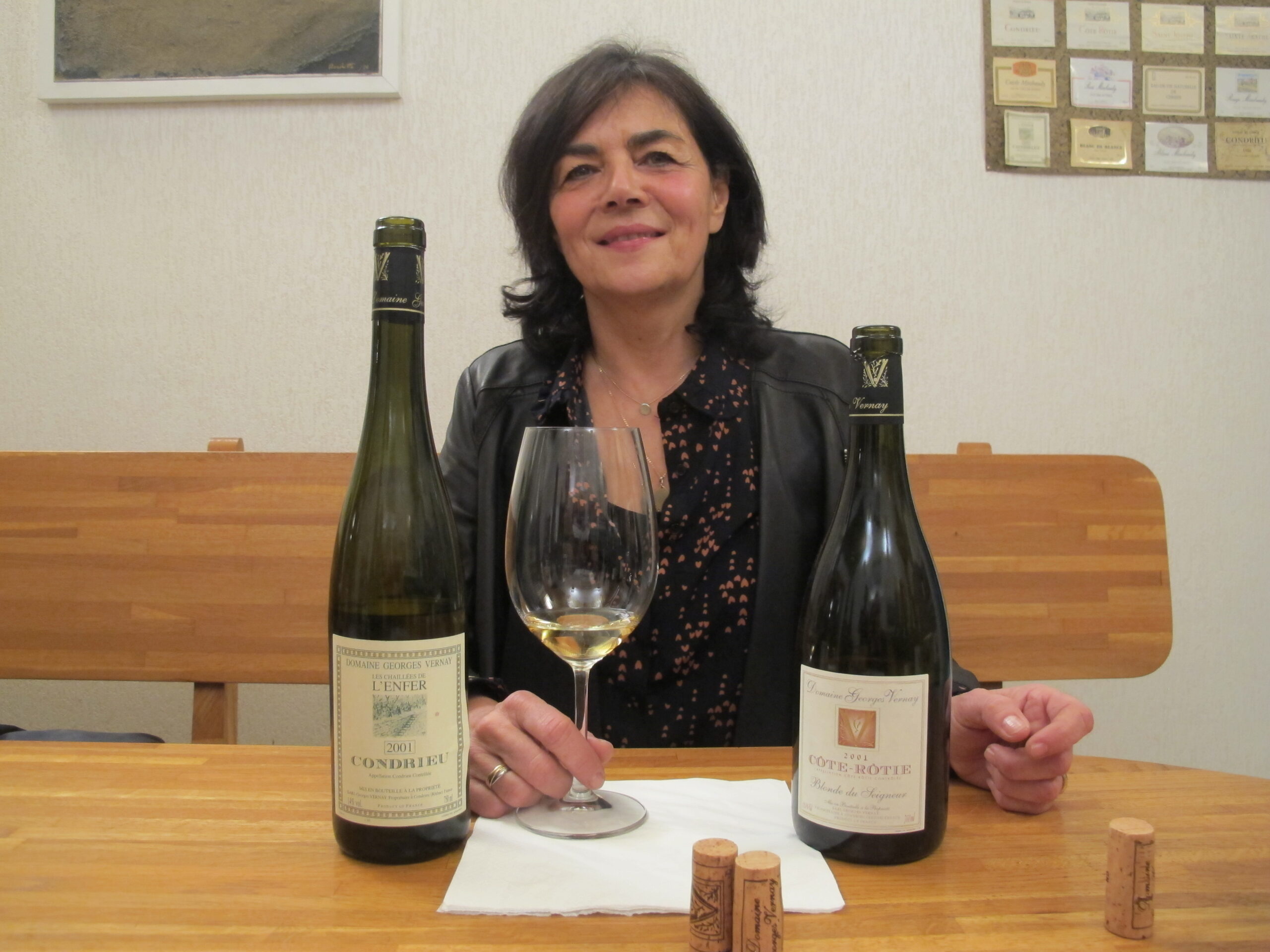Interview with Christine Vernay, Domaine Georges Vernay

Interview with Christine Vernay 5th March 2020 at Domaine Georges Vernay
Edited for clarity and brevity
How would you describe a Condrieu to someone who has never tasted one?
Viognier is an aromatic variety by definition. In Condrieu, this aromatic side is much less exuberant, much less pronounced. There’s a complexity compared to Viogniers from other parts of France or abroad, which display more of this exuberant side.
To describe a fairly classic Condrieu, on the nose you’ll find strong apricot notes, white peach, stone fruit and white flowers. On the palate, you find these apricot and white flower notes again, more or less clearly depending on the vintage. You often find pear aromas as well, more during fermentation than in the finished wine.
In certain terroirs such as the Coteau de Vernon you can still find floral notes but also citrus, thyme. I’m exaggerating a bit, but you almost lose the grape variety on terroirs like this with old vines – terroir has a very strong influence over the variety. On the Coteau de Vernon where I’ve just been replanting some vines, I was impatient to vinify the fruit from these new vines to see if the terroir speaks even in youth.
And the result?
The terroir speaks. Not with the same depth as the old vines or the same structure on the palate, but there’s a similar identity. That was a discovery for me, a real test of the greatness of nature. I’ve never found the same expression as Vernon in my other vineyards, even in my 50-year-old vineyard for Terrasses de l’Empire.
And how about the sensation of tasting a Condrieu, on the palate?
There’s a repeat of what you find on the nose, but also these quite unctuous notes, this glycerol, it’s full-bodied. Depending on the terroir, it’s more or less elongated in shape. For a great wine, you need an elongated shape – if it stays round, it’s not enough. I like to talk about the shape of a wine; you can have square-shaped wines, round shapes, triangular, oval. Condrieu, especially on Vernon or the Chaillées d’Enfer, on particular terroirs, you can find this oval shape… I think it’s one of the characteristics of Condrieu.
With a classic Condrieu you find apricot and floral notes on the palate but I find this less with old vines, which have an intense complexity – less characteristic of the variety but a more detailed aromatic palate. You can have notes of citrus, bergamot, sometimes notes of thyme, lemon thyme. After that there can be exotic notes, lychee, things like that.
Can you say that even a young Condrieu is a complex wine?
Yes, even for a classic Condrieu, but this complexity is accentuated by the terroir. And terroir isn’t just the subsoil, it’s a lot of other things. When we talk about terroir we’re essentially talking about soil, but also the way in which the vines are grown. The way of working, and the man or woman that accompanies this terroir, is also important. To channel terroir you have to be there to guide it. But at the same time, I’m not a not a magician. I can’t convert something that doesn’t already exist. I often make the comparison with the education of a child. The aim of education is to help a child grow, but with a vine or a wine it’s to understand it, in order to help it become what it can be.
I notice you haven’t used the term ‘minerality’.
For me that’s something very abstract. It’s often confused with acidity, when we speak about minerality it’s often about wines with quite pronounced acidity. I use the term very rarely, it doesn’t have a very clear definition for me. A word I use more often when describing Condrieu is ‘salinity’ because it’s a wine that doesn’t have acidity, it’s characterised by this lack of acidity. But Condrieu terroir can generate a saline effect. It’s a term we can agree on because it has a physical reaction: salinity is something that makes you salivate. And despite the lack of acidity, a Condrieu should have this mouth-watering effect. It’s not acidity, but it creates a feeling on the palate.
Is this salinity something you can emphasise when you make the wine?
It’s the whole process of winemaking, to create balance, and this salinity is part of the balance. But one particular process? I don’t think so.
To buy a copy of my latest book, Wines of the Rhône, please click here.

